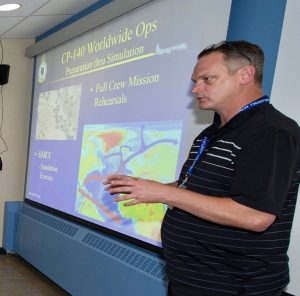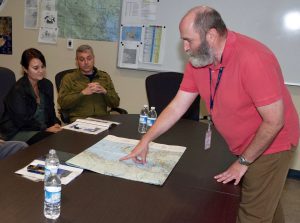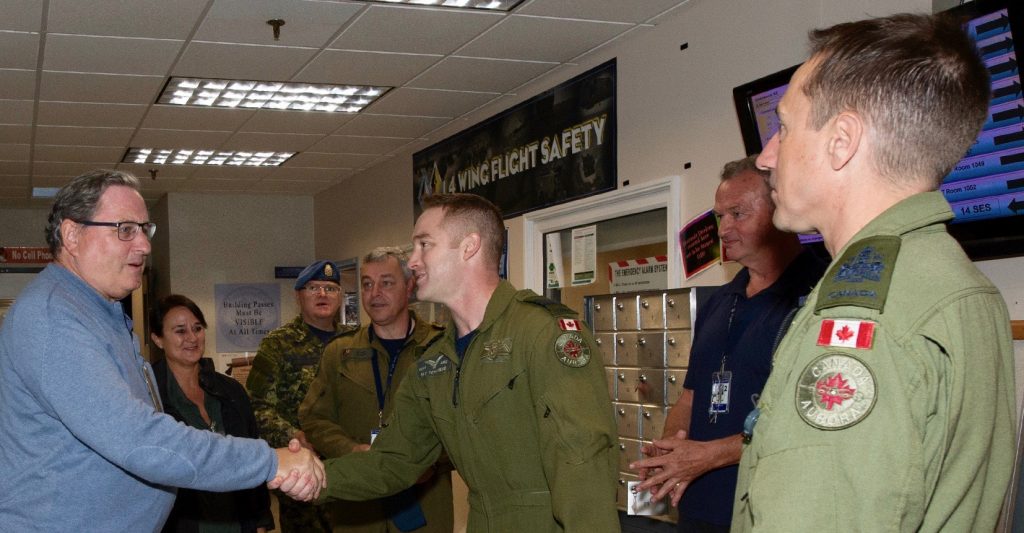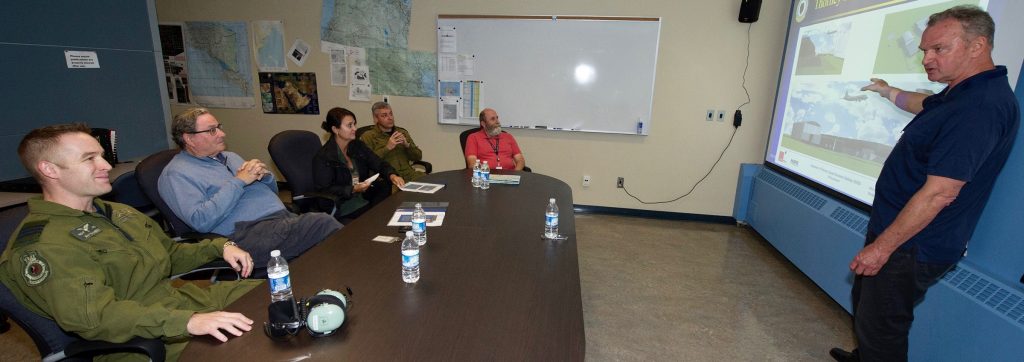2017-10-17 By Robbin Laird and Murielle Delaporte
With the primary focus on the land wars in the Middle East, the priorities has been on the training, skill sets, and equipment for land warfare concepts of operations against an ideologically motivated opponent.
For much of this period, stability operations and counter-insurgency war has been the dominant theme.
This has meant that high intensity skill sets and equipment investments have atrophied or downplayed.
With the return of the Russian global engagement, and Putin’s skillful use of military power, the rude awakening of the second nuclear age with the North Koreans as nuclear extortionists, and the pushing out into the Pacific of the Chinese military, preparation for high intensity or high tempo operations has returned to the forefront.
There is no effective deterrence if there is not a credible capability for competitors and adversaries to take seriously.
But as skill sets are reshaped for the decade ahead, it is not simply bringing back older skill sets; it is about adapting historical lessons learned to 21st century technologies.
This is notably true with anti-submarine warfare, where the new skill sets adapt the alone and unafraid focus of the P-3 crews to the mastery of the new technologies, which allow for an ability to leverage reachback systems, robust networks, and distributed strike.
In the North Atlantic, the U.S. and its allies are shaping what the U.S. Navy calls a kill web approach.
In effect, a Maritime Domain Awareness highway or belt is being constructed from the Canada through to Norway.
And this belt is about shaping a data stream of actionable intelligence to guide decision making for effective strike capabilities and operations. It is not ISR; it is a kill web.
With regard to the UK, Denmark, Norway and the United States, P-8s, Tritons and F-35s are being introduced in shaping a new domain awareness sensor shooter capability for the allied forces.
A key challenge will be establishing ways to share data and enable rapid decision-making in a region where the Russians are modernizing forces and expanded reach into the Arctic.
The return of the Russians in terms of the threat from the Kola Peninsula and building new submarines has come at a time when ASW capabilities have eroded for the allies in the North Atlantic.
The two together – the return of the Russians and the erosion of ASW NATO capabilities – defines the challenge.
How best to meet the challenge in the presence of new 21st century technologies is a work in progress.
Earlier this year, the Norwegians released their threat assessment of the challenges facing Norway.
In that assessment by Norwegian intelligence, NIS head Lieutenant General Morten Haga Lunde stressed when presenting the report, the following with regard to the Russian submarine threat:
“We are seeing an increase in Russian submarine activity and that the vessels are moving further west. Meanwhile their submarines have such well-developed technology that they are becoming increasingly difficult to detect,” he told broadcaster NRK.
Russia’s upgraded and newly developed submarines can move almost noiselessly under water, according to NRK’s report. They also contain advanced missile systems and a water jet system which makes them very difficult to detect at low speeds.
“Russia has undergone a modernization in recent years. They have new submarines, surface ships, aircraft and weapons technology,” Lunde said.
Canada’s approach to engaging in the revival of ASW systems, platforms and skill sets is to evolve the capabilities of its CP-140 and to add a new innovative helicopter to the mix in the North Atlantic and the Pacific.
The introduction of the CH-148 Cyclone is not simply a replacement for the Sea King but rather the inclusion of a new platform within the new maritime domain awareness strike context.
The shaping of a maritime domain awareness and strike enterprise in the North Atlantic to deal with the introduction of a Russian, not a Soviet, submarine threat into the North Atlantic.
New capabilities, among them P-8s and Tritons, are being introduced by Canada’s allies, the US, Norway and the UK, which are part of a broader reshaping of the information and decision making web necessary to deal with 21st century threats.
The helicopter was crafted as a replacement for the Sea King, which could incorporate Romeo type technology into a larger aircraft, which could also do Search and Rescue. And the helicopter had to be designed to land on Canadian sized frigates in high sea states.
The high sea state environment was a calibration made from calculations of deck accelerations.
The helicopter also had to fit within the Canadian concepts of operations, whereby the crew could multi-task while in flight, without a need to return to the ship to reconfigure for changing missions.
The new helicopter is built on a commercial S-90 foundation but the defense customizations fit where 21st century technology was going, namely an information, communications and decision making transformation.
And the work flow onboard the helicopter very much fits into what the Block 3 upgrade to Aurora provides along with the P-8 — the front end and back end of the aircraft shape a workflow for the entire flight and work crew. Screens in the cockpit of both the Cyclone and the Aurora bring the data in the back forward to the cockpit.
 Bill Brown, Senior OMS Officer of 404 Long Range Patrol and Training Squadron (LRP&T Sqn) gives a briefing to Lieutenant-Colonel Ray Townsend, Commanding Officer 404 LRP&T Sqn, Dr. Robbin & Murielle Laird, Lieutenant-Colonel Brono Baker, Acting Commanding Officer 14 Wing Greenwood and Ralph Hippman, Simulator Operator, in the Throney Island Simulation Centre at 14 Wing Greenwood, Nova Scotia, Canada. Photo: MCpl Rory Wilson, 14 Wing Imaging
Bill Brown, Senior OMS Officer of 404 Long Range Patrol and Training Squadron (LRP&T Sqn) gives a briefing to Lieutenant-Colonel Ray Townsend, Commanding Officer 404 LRP&T Sqn, Dr. Robbin & Murielle Laird, Lieutenant-Colonel Brono Baker, Acting Commanding Officer 14 Wing Greenwood and Ralph Hippman, Simulator Operator, in the Throney Island Simulation Centre at 14 Wing Greenwood, Nova Scotia, Canada. Photo: MCpl Rory Wilson, 14 Wing Imaging
A work in progress is to determine exactly who does what, but SA for Search and Rescue is now available to the front end of the aircraft which obviously allows for better decision-making and outcomes.
What the helicopter will connect to in terms of information flow is a work in progress, but the platform is coming to the force PRECISELY when the entire maritime domain awareness and strike enterprise in the North Atlantic is being reworked, and this helicopter has the information tools to both contribute too and leverage the new approaches being shaped.
Along with the introduction of the new helicopter, the CP-140 is evolving its capabilities, or to put into the words of the RCAF Chief of Staff, the “brains” of the aircraft.
The various block upgrades have introduced new technologies for sensing, analyzing and communicating information for operations onboard the aircraft.
http://defence.frontline.online/article/2017/4/8102-Maritime-Threats-to-the-North-Atlantic
But as these new technologies are introduced, training needs to be provided to shape appropriate skill sets both to handle the information and to work in the evolving decision making environment.
And this is being done as the transition is being made from the land war role of the Aurora as an overland manned ISR asset to a back to sea multi-mission ISR/Strike asset.
At the heart of working that transition is the training squadron in the 14th Wing of the RCAF.
And within the 404 Squadron, the RCAF has an impressive simulation capability to shape the way ahead.
During our visit on September 19, 2017, we had a chance to meet with and discuss the challenges with the key members of the 404 Squadron responsible for the simulation training within the Wing.
We met with Lt. Col Ray Townsend, Commanding Officer 404 Sqn, Rodney Ward, Chief Simulation Officer, Bill Brown, Senior Operational Mission Simulator Officer, Rolf Hippman, Operational Mission Simulator Exercise Director, Michel Carriere, Senior Full Flight Simulator Officer and Scott Hale, Full Flight Simulator Instructor Operator.
The team has years of operational experience and serve as Department of National Defence (DND) employees, rather than being contractors.
Under the umbrella of 404 Long Range Patrol and Training Squadron, the Thorney Island Simulation Centre is located adjacent to the Hornell Centre at 14 Wing Greenwood.
Classroom instruction and administration for CP140 aircrew and maintenance personnel take place in the Hornell Centre, while aircrew simulation takes place at Thorney Island.
The Simulation centre is uniquely located within walking distance to all three CP140 Squadrons at 14 Wing Greenwood.
The Canadian government owns the source code for the simulation activity, so that the team can work the simulation environment directly to adapt to evolving developments facing the ASW force.
They work closely with industry in shaping new scenarios for training as well as training on a regular basis to ensure that ASW skill sets are enhanced, even as the overland operations became a key element of what the Aurora force has been doing over the past few years.
It was clear from our discussions, that the team is leaning forward to thinking through how to deal with the new threats and context of the threats in terms of training crews for the decision making and information environment in which they are operating and will operate in the period ahead.
Even though the group has embodied knowledge of doing ASW in the Cold War years, they are keenly aware of the new technological and threat environment.
 Ralph Hippman (right), Simulation Operator of 404 Long Range Patrol and Training Squadron (LRP&T Sqn) provides a briefing in the Throney Island Simulation Centre at 14 Wing Greenwood, Nova Scotia, Canada. Photo: MCpl Rory Wilson, 14 Wing Imaging
Ralph Hippman (right), Simulation Operator of 404 Long Range Patrol and Training Squadron (LRP&T Sqn) provides a briefing in the Throney Island Simulation Centre at 14 Wing Greenwood, Nova Scotia, Canada. Photo: MCpl Rory Wilson, 14 Wing Imaging
And like the rest of us, they are sorting what it means for concepts of operations for a 21st century combat force.
The simulation training facility provides a significant complement to real world flying, something especially crucial when flying an older aircraft, even if it has seen a service upgrade on the airframe. As with other air forces, there is the challenge of striking the right balance between simulated operations and actual flying operations.
According to Lt. Col. (retired) Rodney Ward, Chief Simulator Officer:
“The Aurora fleet allocates flying hours between operations and training, and what we call these days Force Employment and Force Generation, respectively.
“In all the RCAF military fleets today it has become important to Commanders – who are minding their bottom-line budgets, that the ratio of simulation flying to real flying is at a high proportion so that they can demonstrate that they are wisely obtaining the necessary training for their troops. It is more cost effective to simulate where you can & conserve the real aircraft for real operations, not training.
“This fleet is doing very well in that respect as our simulation hours (all four devices) run at approximately 73% of our annual real flying rate.
“Combining this fact with the powerful learning value of authentic and well researched simulation makes me proud to say that this fleet exploits simulation very well.
“The payoff is that we have managed to carry through the last decade, with very few Op Force playmates out there on the high seas, with lots of very valuable Force Generation through simulation.
“We always challenges crews so that they come away with a ‘been there, done that’ moment, what we refer to as ‘experiential learning’.
“We have thus kept our ASW sword quite sharp despite significant peace dividend challenges.”
The well-researched simulation point is especially important when looking at the new strategic, technological and operational environment.
A key event for the simulation team is the annual SIMEX exercise. Here the force is tested against creative scenarios, which test challenging conditions to operate in coalition to be able to make decisions in hybrid environments.
We raised the question of flying in simulators and not getting a sense of what failure actually means in combat.
They provided two responses to this challenge.
First, because of the operations in the land wars, their ISR role has exposed them to getting shot at.
So there was a real world sense of danger drawn from those experiences.
Second, the major SIMEX exercises are crafted with an eye to recording actions and events so that failures are visible and crewmembers take those lessons learned forward as peer competition underscores success and failure in the process of learning from simulated combat operations.
 Dr. Robbin Laird (left) is greeted by Lieutenant-Colonel Ray Townsend (centre), Commanding Officer 404 Long Range Patrol and Training Squadron, in the Hornell Centre at 14 Wing Greenwood Nova Scotia, Canada. Photo: MCpl Rory Wilson, 14 Wing Imaging
Dr. Robbin Laird (left) is greeted by Lieutenant-Colonel Ray Townsend (centre), Commanding Officer 404 Long Range Patrol and Training Squadron, in the Hornell Centre at 14 Wing Greenwood Nova Scotia, Canada. Photo: MCpl Rory Wilson, 14 Wing Imaging
The SIMEX exercises are a yearly event and were described as such as follows:
“SIMEX is a yearly program where the crews go through an iteration of training with the most experienced people we have.
“The simulator operators are the people from 404 squadron at the Wing.
“The crews are operating on their own as they would on a mission and they’re getting tasks, which are very realistic.
“They are operating in a realistic combat environment right down from the messaging format with regard to how they brief and right up until the end; and they’re real time missions, they’re very long.
“At the end of SIMEX they get an assessment of how they did.
“That gives the commander here a picture of what is the state of affairs with the personnel and its performance levels.
“Because we do it every year the crews are on an upward learning curve. It’s an interesting program that has maintained and improved ASW skills for us, for the fleet.”
The focus is on training for a complex, dynamic and fluid combat environment.
As Lt. Col. Bruno Baker put it:
“When I started in the fleet the synthetic environment provided training based on a number of canned scenarios.
“These were cold war based scenarios that you saw repeatedly as you operated.
“They told you what scenario it was, you just went in your drawer and you pulled out your notes from your earlier training and experience and you just re briefed whatever you briefed every time you did this.
“The scenario was always the same, with some minor changes, but you always knew what you were getting into.
“It became repetitive it became a procedure trainer.
“Now this is a different ball game altogether.
“The people crafting the scenarios are gifted at coming up with relevant current scenarios that aren’t procedure trainers, but are making our crews problem solvers.
“It’s about training your crew that is capable of operating in a complex environment and being able to make decisions in such an environment.
“It is moving beyond being alone and unafraid to becoming an operational decision maker within a coalition in a 21st century maritime threat environment.”
This Canadian simulation center can make an important contribution not just to Canadian but to NATO defense as it is linked up with other ASW forces coming on line in the UK, Norway and the United States.
In fact working the intersection of new platforms and capabilities on the allied side with the evolving capabilities of the Canadian force can be a key part of what the center can assist in going forward.
And the simulation team sees a key role for Canadian forces in the transition NATO effort as they themselves transition.
According to LCol Ray Townsend:
“We’re well positioned for the next decade to be a stopgap.
“We’re able to be the ones that can perform key 10’Oclock and 2’Oclock duties for Canada and North America in the ASW area.
“There are so many other nations that are transitioning right now with the introduction of the P-8 and Triton, from Australia to the UK to the Americans, to Norwegians.
“A lot of people are doing that transition right now, and as you know with any transition there is significant downtime.
“We can provide a major role as the transition unfolds.”
 Rod Ward (right), Chief Simulations Officer of 404 Long Range Patrol and Training Squadron (LRP&T Sqn) gives a briefing to(from left to centre) Lieutenant-Colonel Ray Townsend, Commanding Officer 404 LRP&T Sqn, Dr. Robbin & Murielle Laird, Lieutenant-Colonel Brono Baker, Acting Commanding Officer 14 Wing Greenwood and Ralph Hippman, Simulator Operator, in the Throney Island Simulation Centre at 14 Wing Greenwood, Nova Scotia, Canada. Photo: MCpl Rory Wilson, 14 Wing Imaging
Rod Ward (right), Chief Simulations Officer of 404 Long Range Patrol and Training Squadron (LRP&T Sqn) gives a briefing to(from left to centre) Lieutenant-Colonel Ray Townsend, Commanding Officer 404 LRP&T Sqn, Dr. Robbin & Murielle Laird, Lieutenant-Colonel Brono Baker, Acting Commanding Officer 14 Wing Greenwood and Ralph Hippman, Simulator Operator, in the Throney Island Simulation Centre at 14 Wing Greenwood, Nova Scotia, Canada. Photo: MCpl Rory Wilson, 14 Wing Imaging

